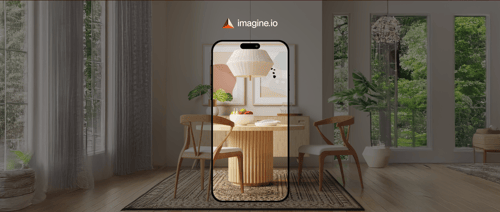Table of Content
- The Tariff Squeeze is Real - Here’s How Smart Brands Are Responding
- Traditional Asset Creation Is Slowing You Down and Eating Your Budget
- 3D + AI: Not the Future. The Now!
- Why This Matters in a Tariff-Heavy Economy
- Real-World Impact: 80% Cost Savings with 3D & AI-Driven Strategies
- Quality, Speed, and Flexibility—Without the Price Tag
- The Big Picture: Rethink Where Your Budget Goes
- Final Thought: Adapt, Don't Just React
Let’s face it—tariffs are cutting into your margins.
If you're a product manufacturer or brand leader, you're likely already feeling the squeeze. And it's not just on niche categories—everything from raw materials to finished goods is getting hit.
Now you’re stuck between two bad options:
- Raise prices and risk losing customers
- Absorb the cost and watch your margins disappear
Neither is ideal. But what if there’s a third path—one that protects your margins without sacrificing growth, product quality, or customer experience?
Here’s what smart brands are realizing:
👉 The place to start isn’t your product pricing. It’s your product content.
Yes, one of the most overlooked line items on your P&L is your visual asset pipeline—think photography, video, set design, and post-production. It's expensive, slow, and increasingly outdated in an era of AI and 3D. In this blog, we’ll break down how innovative brands are using 3D rendering and AI to slash costs, speed up content creation, and deliver high-impact visuals—while staying ahead of tariff challenges.
Let’s dive in.
Traditional Asset Creation Is Slowing You Down and Eating Your Budget
For years, brands have followed the same high-cost, high-friction playbook for product imagery. I know—I’ve lived it as an ex-eCommerce leader. Studio shoots are slow, inflexible, and expensive.
Here’s what a typical shoot might include:

- Studio rental + photographer: $15K/day (or more)
- Stylists, props, set design, shipping: Thousands more
- Post-production, editing, reshoots: Weeks of delays
Multiply that by:
- Dozens of SKUs
- Multiple channels and campaigns
- Seasonal and regional refreshes
You’re staring at hundreds of thousands in annual content costs—at a time when tariffs are already chipping away at your margins.
3D + AI: Not the Future. The Now!
Fortunately, 3D rendering and AI-powered content tools have gone mainstream—far beyond tech and gaming. Today, brands in furniture, home goods, apparel, and beauty are embracing them.
|
Traditional Studio Shoot |
3D + AI Workflow |
|
Expensive, slow, manual |
Affordable, fast, scalable |
|
Limited customization |
Infinite colorways, angles, and environments |
|
Static assets |
Interactive, dynamic visuals (AR/VR ready) |
|
Delays due to logistics |
Instant digital delivery |
And yes, the visuals are photorealistic. Customers can’t tell the difference—and often engage even more with interactive, high-resolution 3D content.
Why This Matters in a Tariff-Heavy Economy
Tariffs make importing, manufacturing, and shipping more expensive. That means you have to find cost savings somewhere—and content creation is ripe for reinvention.
Here’s how 3D and AI help offset tariff impact:
1. No More Physical Prototyping
Skip overseas sample shipments. Visualize and market products before they’re produced—saving time, tariffs, and freight.
2. Create Region-Specific Content Without Travel
Need U.S. lifestyle shots and Asian eCommerce layouts? Render scenes digitally. No shipping, no sets, no local teams.
3. Scale Without Scaling Costs
Generate thousands of variations—colors, configurations, bundles—at a fraction of the cost and time of a photoshoot.
4. Stay Agile When Markets Shift
If tariffs swing overnight, you can react instantly—launch new visuals, bundles, or SKUs without waiting on inventory or photography.
Real-World Impact: 80% Cost Savings with 3D & AI-Driven Strategies
Brands making the switch are seeing eye-popping results:
- Up to 80% savings on eCommerce content production
- Faster launches and time-to-market
- More visuals per product = more engagement and conversions
- Higher sales, lower content costs, and repurposable assets
And it goes beyond content.
Some brands are combining 3D rendering with on-demand manufacturing—like localized 3D printing through platforms such as Stratasys Direct. That means:
- No duties or tariffs on prototype shipments
- Faster sample turnaround
- Zero warehousing costs for parts or imagery
Quality, Speed, and Flexibility—Without the Price Tag
Let’s be clear: this isn’t about sacrificing quality. It’s about unlocking more—more control, more scalability, more speed.
- Launching a new collection? Render before samples arrive.
- A/B testing PDP layouts? Generate image variations instantly.
- Need silos, lifestyle shots, or 360° videos? Done—without a physical studio.
The Big Picture: Rethink Where Your Budget Goes
With today’s economic pressures, you can’t keep doing things the old way.
Old model:
- High costs
- Long timelines
- Rigid workflows
3D + AI model:
- Lower costs
- Instant production
- Flexible, scalable content
Final Thought: Adapt, Don't Just React
Tariffs aren’t going away. The brands that win will be the ones that don’t just react—they adapt.
They’ll invest in smarter tools, faster workflows, and scalable systems. They’ll use 3D and AI to regain control over costs—without compromising on quality.
This isn’t just a creative upgrade. It’s a survival strategy. Ready to see what that could look like for your brand?
Let’s talk. We’ll walk you through what it takes to switch from studio shoots to a streamlined 3D workflow—and start saving right away.





.png?width=500&name=How%20to%20Add%20a%203D%20Product%20Configurator%20to%20Your%20WordPress%20Website%20(Complete%20B2B%20Guide).png)
















%20(1).png?width=500&name=Why%20Exploded%20Mattress%20Views%20Matter%20(And%20How%20to%20Generate%20Them)%20(1).png)
.png?width=500&name=Best%20Shopify%20Product%20Configurator_%20How%20to%20Choose%20the%20Right%20One%20(2).png)
.png?width=500&name=Why%20Exploded%20Mattress%20Views%20Matter%20(And%20How%20to%20Generate%20Them).png)



.png?width=500&name=Best%20Shopify%20Product%20Configurator_%20How%20to%20Choose%20the%20Right%20One%20(1).png)







.png?width=500&name=How%203D%20Rendering%20Can%20Make%20or%20Break%20Your%20Industrial%20Design%20Pitch%20(1).png)








%20with%20Digital%20Twins%20and%203D%20Visualization.png?width=500&name=Optimizing%20Your%20Digital%20Asset%20Management%20(DAM)%20with%20Digital%20Twins%20and%203D%20Visualization.png)




.png?width=500&name=Styling%20Home%20Decor%20for%202025_%20From%20Global%20Influences%20to%20Playful%20Personalization%20(1).png)
